A friend of mine once commented that to the uninitiated, it must seem completely ridiculous we are playing board games for fun. We were fretting over some heavy euro, probably the original Caylus or something similar. Everyone around the table could be seen mildly frustrated that they were missing that one resource they needed or living in fear that the player to their right might snatch up a worker placement spot they desperately needed. Oh of course we were having fun, Caylus was a revelation when it came out! But try to explain to someone why and you might have a hard time getting your point across.
Things look very different for Burgle Bros 2: The Casino Capers: unusual-sized box that looks like a building with a car jumping out of a window? Looks fun. Playing a casino heist? Sounds fun. Comic art style: fun yet again. You can transform the box to act as the second floor playing area? Get out of here, you can’t be serious! If you ever wanted to convince someone that modern board games can be fun, this might just be the easiest pitch you can make. But is it?
Well, let’s take a closer look and see if we’re up for a good time or this is just ridiculous.
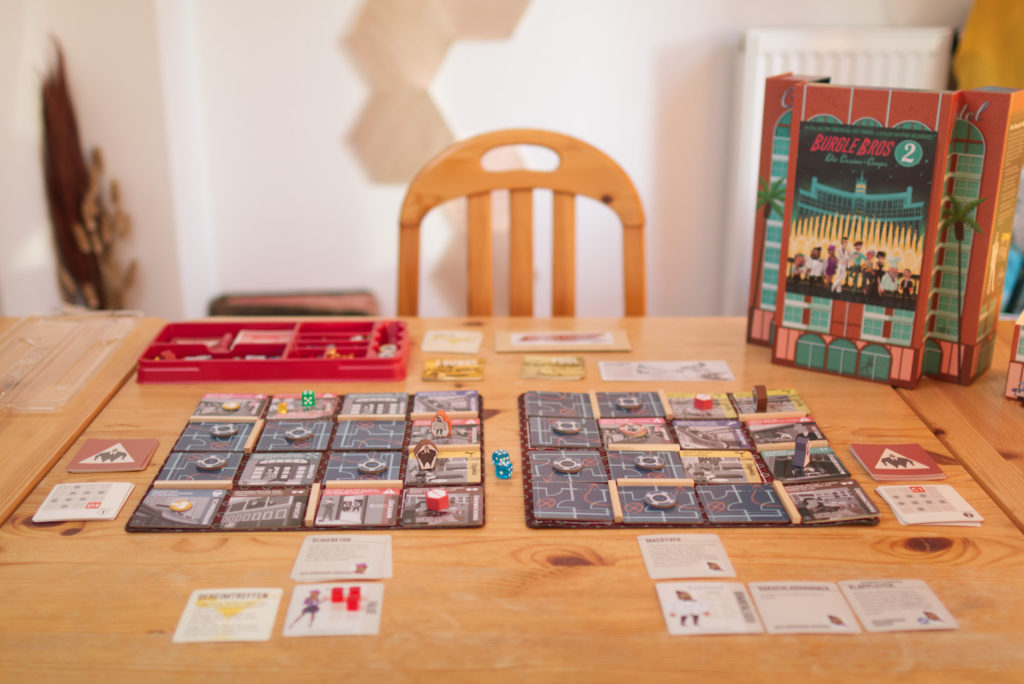
Unboxing
I typically don’t like to talk about components and rather directly dive into the game. But I would be amiss if I wouldn’t talk about the presentation here. Burgle Bros 2’s box has quite an unusual shape and structure. It’s rather tall and its outside is fittingly styled like a building. At the bottom is sort of a sleeve that once removed allows you to unfold the box to a square footprint.
Inside each of the two side-compartments, you’ll find two transparent legs and a rolled up playmat. Stick the legs into the corners of the unfolded box, flip it around, place one playmat on top of it, the other underneath, and you have the two levels of the casino that will be the scene of our heist.
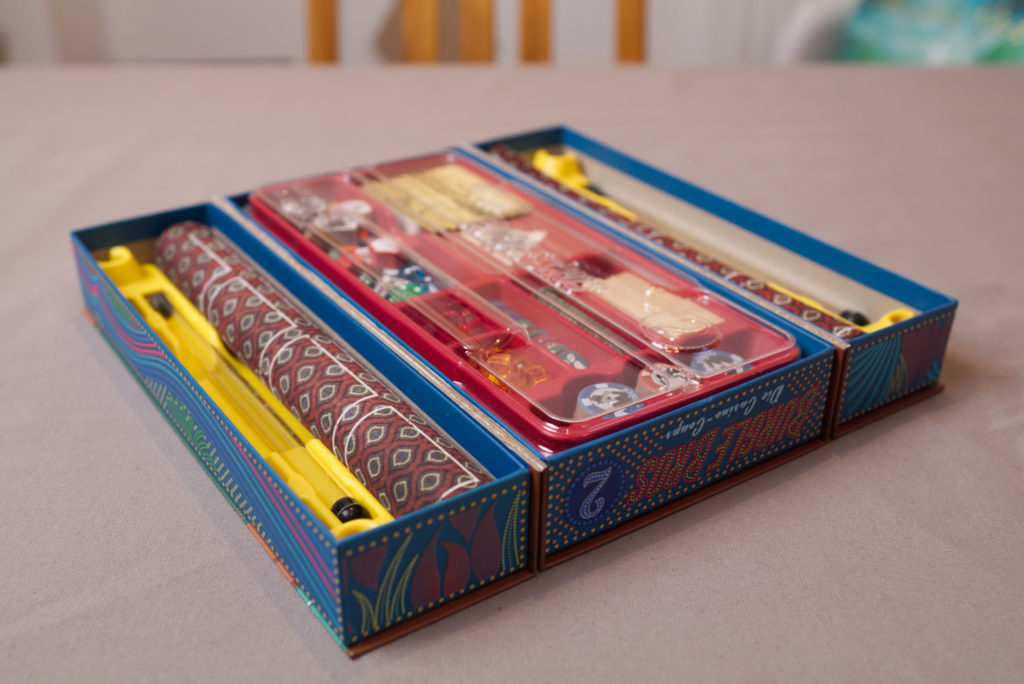
In the center-compartment of the box, there is a nice plastic tray with a transparent cover that contains all the player pieces, cards and other smaller components. There is a lot of stuff in here: 9 wooden player pieces (with stickers), 2 guards, various oddly shaped wooden tokens that don’t make any sense at first (we come back to those later), red and orange transparent cubes, large wooden sticks, … let’s just say it oozes variety. It looks like an inviting buffet of game pieces and immediately produces an “oooooh” in new players. Underneath the tray are the 32 large cardboard tiles that represent the locations inside the casino. You’ll also find two envelopes we’ll talk about later.
For completeness sake, I should mention that there were production issues during the kickstarter campaign. Apparently some of the patrol cards had color issues with their card backs and replacements were sent out. That’s why my German copy has a few patrol cards that have the English term “floor” and the rest the German “Stockwerk”. But it’s tiny font. It’s not really an issue, more a curiosity (I don’t think anyone I played with even noticed it).

Another issue is the main attraction: using the box as a raised second floor. Due to the way the sides are attached, the center section actually hangs a bit lower than the sides if you prop it up on the four legs. This can be easily fixed by using some of the unused circular cardboard tokens and sliding them into the gaps between the side and center compartments. Works fine, I had no problems doing that though it feels weird. The bigger issue for me personally is that one of the yellow leg holders has not been glued in correctly in my copy and therefore one of the legs always falls out when I open the box. All of this is a bit of a shame because so much heart and soul has been put into the tray, the pieces, the artwork, and all the rest of the production. Luckily, none of it was really an issue for me. My guess is that the vast majority will not use the propped up second floor more than twice anyway, so the box issues are mostly moot. I myself actually do from time to time, even if it isn’t really practical.
Setup
Unroll the two playmats with their 4×4 grids, either use the box as a second floor or – the more practical solution – just put them next to each other. The 32 location tiles are separated and shuffled such that the office is always on the first floor, the safe is always on the second floor, and there is one escalator and monorail on each floor. Place one tile face down on each space of the playmat. Find the first and second floor patrol card decks, give them a good shuffle and reveal the top cards. This marks both the spot where the guard on that floor will start as well as where a random assortment of casino guests (stylised as cardboard casino chips) are placed face down. Draw another card to figure out the first target location of the guard and mark it with the respective wooden marker. You also need to place 8 walls on each level with not much more rules than that each room needs to be reachable. Place the two entrance cardboard markers in corners on the first floor and the location of your heist is ready.
As mentioned previously, the game contains 9 playable characters. Each player gets assigned one at random, receiving the character card as well as three character-dependent pieces of gear (cards). Finally, open the larger envelop, retrieve the first finale card and read the flavour text on the front but NOT the rules on the back. This is your mission. To not spoil anything, I’ll just make something up. Let’s say your gang has heard a rumor that the casino boss has a stolen, cursed Incan idol in his safe that you want to get back to the authorities… for a fair price of course.
Game Arc
Burgle Bros 2 works in two acts: Your mission always starts with you entering the casino, locating the office and the escalator that allows you to reach the second floor, going up to locate the safe and then crack it. Along the way, you have to find a couple of insiders among the guests that improve your chances of opening the safe.
Once it is open, and only then, are you allowed to read the back side of the finale card. This will perform some minor setup changes to the casino, introduce a new rule and a way how you are supposed to leave the casino (you guessed it, there are way more exciting ways to leave than the entrance). In our fake scenario, this might be that the player that cracks the safe gets a wooden idol token and from that time on has ridiculously bad luck. If he runs into a drunk patron of the casino, they bump into each other and he looses the idol. If he runs into a prima donna, she loudly exclaims what a gorgeous idol you have, immediately attracting the attention of the guards. And every time you move, you have to roll a die to see if you actually move or just stumble and have to pick yourself up. Stuff like that. The finale cards turn everything upside down and if you’ve thought it’s hard to crack the safe without being detected, the heat is on once you do!
The Turn
So how do you do it? When it is your turn, you have four actions. With each of those, you can either move, scout, use the location you’re at or ready a piece of gear. Movement is what you do the majority of the time: you move your character piece to an adjacent tile and first reveal the chip that’s lying on it if there is one. There are three categories of chips: blue chips can help you, yellow chips are only activated if you didn’t move into the room but just scouted it from an adjacent tile (the second, more careful but slower type of action a player can take), and red is activated when you move into the location. As an example, if you reveal a drunk patron of the casino (red), you slide one further square into the same direction you moved and won’t reveal the location you originally intended to check out. On the second floor, they are even worse: you drop down to the first floor if you run into a drunk!
Being a bit more cautious and rather scout first can help. You’ll be loosing precious time but you’ll see what you will run into. If you scout and reveal a red chip, it is discarded which feels like having diffused a mine. Especially the red saleswoman chips are nasty because they block you from any further movement until one of your friends busts you out. However, scout and reveal a yellow chip and you have done the opposite of what you wanted to achieve: you’ve triggered their effect. There are way more red than yellow chips, so the odds are good, but…
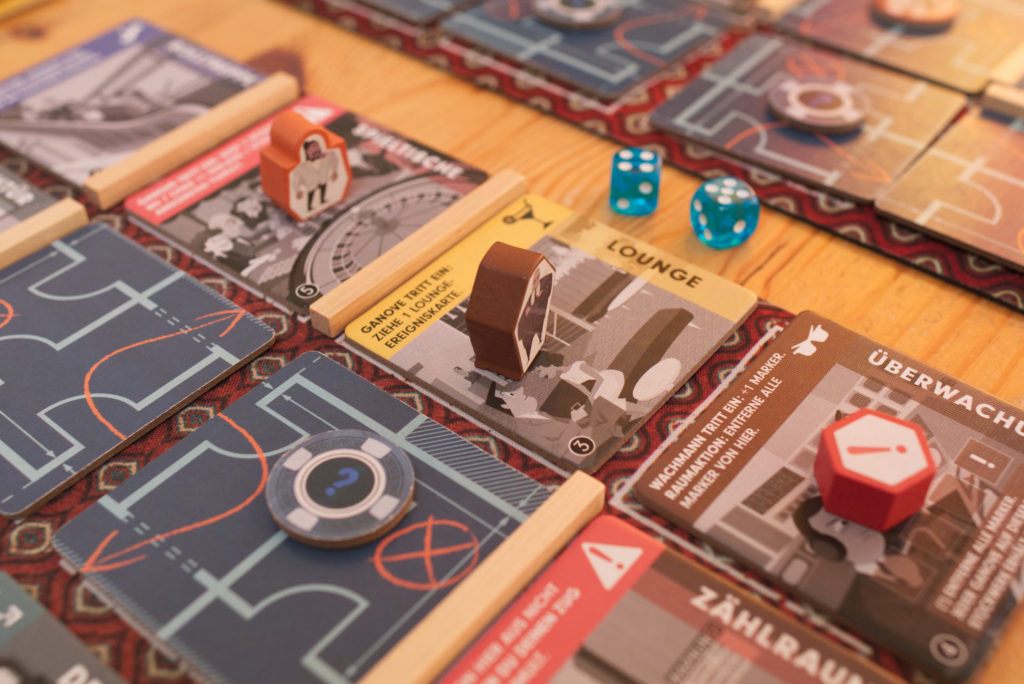
After dealing with the consequences of the chip, you reveal the cardboard tile representing your new location. The pool and lounge trigger a random event, the magic show allows you to spent an action to move through a wall to an adjacent square, and so on. Some offer you an optional action to take, some trigger automatically when a player character moves in, some when the guard moves in.
Speaking of guards, there is one on each floor and they usually have a target they want to check out represented by a wooden marker. At the end of your turn, the guard of the floor where you ended up moves 3 squares towards its target, taking the shortest route respecting all walls. If it reaches its target, draw a new card from its patrol deck, move the target marker to the indicated square and continue moving it. If a guard ever ends up on the same square as a player, that player gets two stress (red transparent cubes). If anyone gets their sixth stress, the game is immediately lost. But that doesn’t necessarily mean the game ends when you have encountered the guard three times: there is ample opportunity to pick up stress while traversing the casino. Being a criminal is a stressful job apparently.
Circumventing and hiding from the guards is one of the major aspects of the game. What makes things worse is that there are a number of locations and events that can cause a commotion. In such a case, the target marker is placed on the square the commotion happens and the guard immediately (in addition to its end-of-turn movement) moves one square towards it. So if you are not careful while exploring the casino, you can get yourself into a real pickle. Causing a commotion can also be used in a positive way to change the route of the guard, though typically one should avoid this.
There is one situation where it can be very helpful though: once the patrol deck of a guard has run out, it goes into alert mode and will from now on move towards the closest criminal. This is rather deadly and once you hit this point, you typically won’t last long. However, causing a commotion gives the guard a new, temporary target to go to and it gets distracted from you and your band of casino robbers until it has checked out that target.
Finally, you can use one of your actions to ready one of the three pieces of gear you received at the beginning of the game. These are dependent on your character and enable you to do stuff like moving a wall, jumping out of a window and stepping into the casino on the opposite site, confuse the guard, etc. The nice thing is that once they are ready, you can use them even on another players turn, giving each other assists.
End of Game
The game ends when either someone has received their sixth piece of stress or you successfully opened up the safe, dealt with the finale and escaped the casino. To crack the safe, you have to locate the office, the safe and reveal all locations in the same row and column as the safe. Each location shows a number from 1 to 6. When your character is at the safe, you can spent an action to roll all dice on the safe and cover any matching number on a location tile in the row/column with a crack token. Got all six covered? You have just cracked the safe.
“Dice?” I hear you say? Where do the dice come from? Some of the chips spread all over the casino are moles, inside informers that help you. If you are on the same square as a mole, you can spent two actions to remove it from game and instead put a green die on the office. There are four moles hidden throughout the casino, so you can get a maximum of four dice (a fifth one is only available through a special piece of gear). When a character is at the office location, that player can spent an action to move one die up to the safe. So to sum up: find the moles to get green dice, go to the office to move them up to the safe, be at the safe to roll them and put crack tokens on the matching locations. Oh, and each time you attempt to crack the safe, you have to return one of the dice back to the office! So better have someone down there, ready to get them back up if – or rather when – things don’t go as quickly as you hoped.
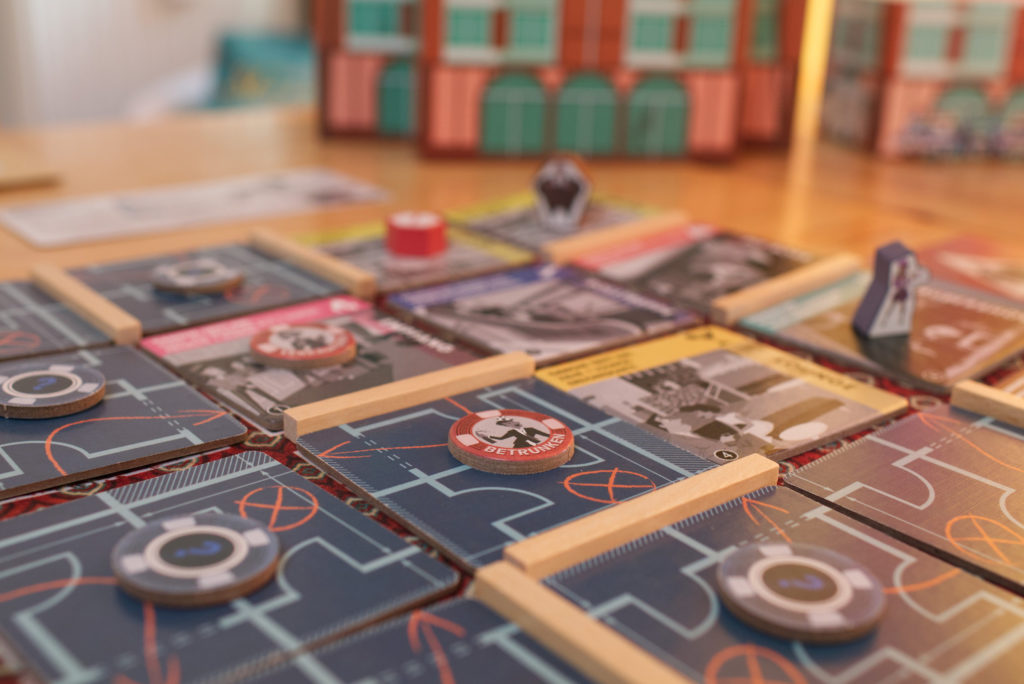
Casing the Joint & Solo Mode
Location placement, lounge/pool events, patrol deck, chips, die rolls, … there are lots of random elements in this game, which isn’t everyone’s taste. The author has therefore introduced a second play mode called “Casing the Joint” (CtJ) in an update (which can be found in the BGG file section). In CtJ, locations are still hidden but what guest chips are on what floor is fixed and the chips are revealed during setup. The function of a number of chips has also changed. For example, the drunk no longer moves you to a different square but sticks with you and prevents you from using the location action. The saleswoman still prevents you from leaving a square, but you can spent 3 actions to move her to the other floor. Other chips have changed as well. Finally, the pool and lounge decks are face up so once you know their location, you know if you have to avoid them or can use them for your advantage.
This changes the dynamic to almost a different game. Where standard mode just throws you into the madness and lets you discover what you ran into on the fly (which is great for new player), CtJ makes the game way more puzzle-like. There is still some randomness due to the unknown locations and the patrol decks, but it feels… fairer? Memorising the functions of the different chips is a bit of a pain though and learning a different set of rules takes a bit of getting used to. When I first started playing the game, having to look up the function of the same chip multiple times because it wouldn’t stick was probably the most frustrating experience within Burgle Bros 2 for me. Now I’m ow them by heart. Having to re-learn this for CtJ took another 2-3 games. But it’s worth it. I still recommend standard mode, but CtJ is nice especially for playing solo.
The solo mode is easy to explain: pick two characters, alternate the turns, done. There are no special rules here. It’s still surprisingly satisfying though because you typically will use one character for staying on the first level, talk to the moles, and the other to move to the second floor and scout for the safe. One may collect more stress than the other, the gear from one can help out the other, and so on. It’s almost like I’m doing teamwork with myself.
Miniatures
There is an optional set of plastic minis available that is compatible to both Burgle Bros 1 and 2. I only got it recently but really enjoy using it. They are rather chunky which I like. You should be aware though that the miniatures much more resemble the artwork from Burgle Bros 1 than 2, so much so that I had some initial problems identifying which miniature matches which character card. I wish they would have had a slight wash of color so at least the guards could be easily distinguished from the player characters. The other slight issue I have is that they are rather tightly stuck inside the trays. Whenever I take them out, I always have the feeling I might break or scratch something if I’m not careful and you definitely have to handle them at the base. The female characters have such thin legs that I can easily see them snapping off the base. So if you have the space – or plan painting them -, my recommendation is to plan for permanent shelf space and not put them back into the trays.
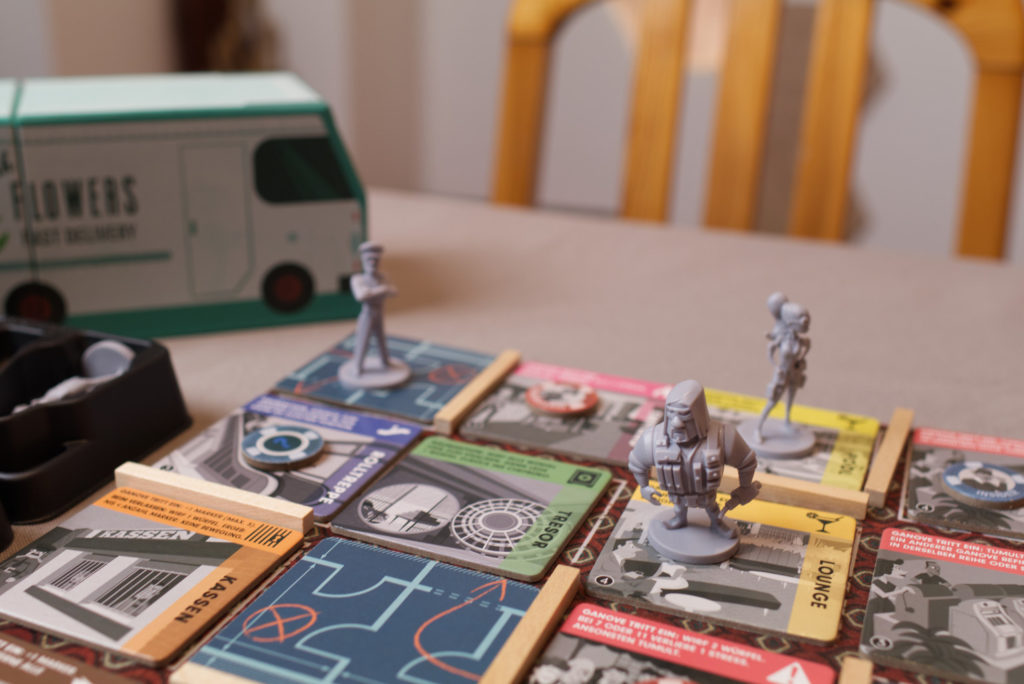
Conclusion
So is Burgle Bros 2 fun? If you ask me, it’s a resounding “heck yeah”! I was totally surprised by how much I enjoyed the game and everyone I introduced it to also liked it. It has the “let’s all work together” aspect of a Pandemic but with hardly any alpha-gamer tendencies. The concept is so easy to grasp that everyone has an opinion within 3-4 turns and no one keeps all the possible gear of all players in their head. The game’s absurd randomness constantly throws a wrench into your best crafted plans. So after the second time you accidentally triggered a pool event or stumbled into an undercover detective, you just shrug and wing it. It’s not the type of game where you feel you lost because you weren’t clever enough. It’s more the type of disaster you willingly head into because a) you don’t care and b) it’s fun. The knowledge that even the most experienced Burgle Bros 2 player can fail when facing an unexpected room-wall-guard placement is somewhat of a relieve. To put it bluntly, this is probably the game where I care the least whether I will succeed or fail because I know I will have a good time either way.
Still, experience does help. There are moments where you put your head into your hands and shout “I should have seen this coming”. Or you suddenly come up with a clever ploy. The other day I had a session where one character was on the second floor exploring and the other on the first, sneakily not moving at all for multiple turns because he found a good spot where the guard moved just past him. I was so smug when I figured out that I didn’t have to move at all and everything would be fine.
My favourite aspect – besides the lovely theme and artwork, besides the luxurious tray, besides all the individual card board tokens and transparent cubes – is the finale mechanism. It’s such a wonderful idea to get a tease in the beginning and the exact rules only after you are two thirds through the game and already neck deep in trouble. The scenarios I’ve seen so far were all thematically fitting and induced a healthy dose of “oh no, not that now”. There are 8 finale in the box (remember the envelopes? One is for the finales, one for the rewards) and a ninth has been released as part of the aforementioned update. For a number of them, you’ll find some dedicated piece of cardboard or wooden token in the box. It’s more than enough to get you hooked on the game in general and keep you coming. I really hope though there will be additional ones in the future, like monthly new free scenarios or a pack of 30 as a mini-expansion.
As I said before, I really enjoy Burgle Bros 2. It’s good, approachable fun, a game takes about 30-45min and though setup is a bit more involved than I would like it to be, it’s quickly done. The puzzle of how to avoid the guards and how to not deplete their patrol deck too quickly is a good one, though it won’t be for everyone. There is a big amount of luck, randomness or chaos, whatever you want to call it. In one game, the escalator up was in the last place we checked and by that time – due to some unfortunately location placement – our crew had already run into the guard multiple times and we were close to getting busted. We managed to get to the safe but had no chance of actually cracking it, let alone discover what the finale would be. If on the other hand the escalator is close to the entrance, the team can split up quickly and the guards become way more manageable. Running into a drunk on the second floor can also be pretty painful, depending on where you land on the bottom floor.
While there is a mechanism to adjust the game’s difficulty via extending/reducing the patrol decks, I had the strong feeling that the difficulty was much more dominated by your luck in location placement or patrol deck order. I had some rounds where the guard moved onto its target on its first movement, drew a new target that just was right next to it, moved on to it with its second movement, and then drew yet another target that was not too far away. Within a single round, this brought us way closer to the guard being alert. The rules suggest adding no-movement cards if the game gets too hard or removing patrol cards if it gets too easy but I stopped bothering and just play with the normal deck compositions. The wall layout also has a large influence and I wished the patrol decks would have been used to somehow give me a good layout each game. I’ve found an online Burgle Bros wall layout generator which I now use quite often. Finally, included play mats are nice but the fact that I have to roll them up each time means they never, ever really stay flat. Luckily I’m not too OCD about stuff like it. Well, maybe a little… you have to agree, it is somewhat annoying, don’t you? Don’t you?
So there you have it. Is Burgle Bros 2 fun? Definitely! Will you be able to enjoy it? Depends heavily on how you react to substantial changes in difficulty due to randomness. This is not a meticulously planned heist. It’s a crew being thrown into chaotic circumstances. And chaotic can be a lot of fun apparently!
